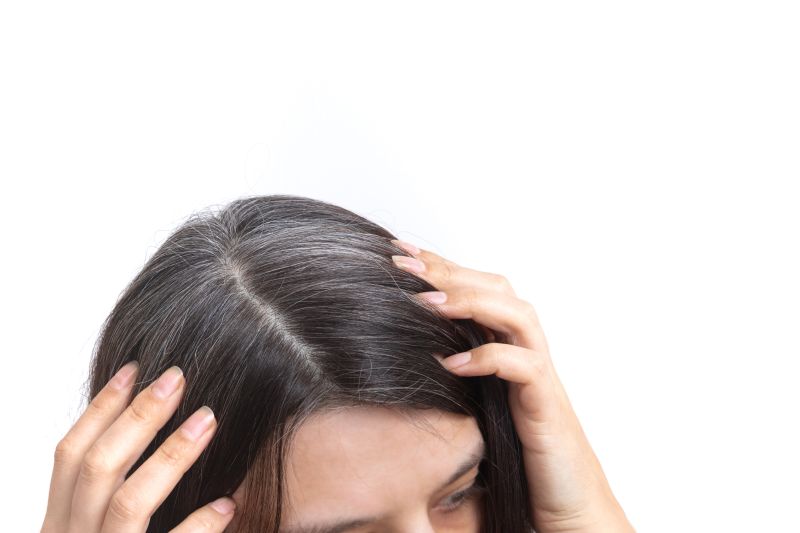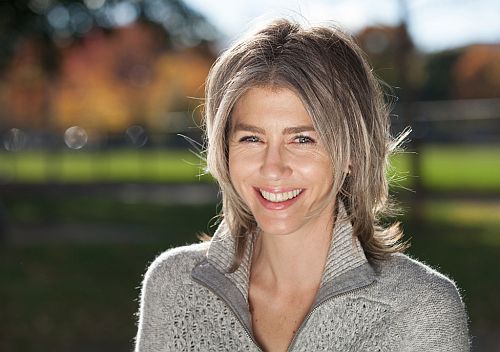Last Updated on December 19, 2022 by Gaga
By Rose Keefe
Gray hair is finally getting the respect it deserves. Not too long ago, we reacted to those first grays by running to the stylist for permanent color. Now we’re embracing the change. Celebrities like Jamie Lee Curtis, Meryl Streep, and Glenn Close are all celebrating their silvers, and even younger stars like Lady Gaga are going for a flawless combination of gray hair and highlights.
You can too. Showing off your grays has become synonymous with celebrating your natural beauty, and when you blend them with flattering highlights, the effects can be showstopping and surprisingly easy to maintain.
So how do you get started? Read on!

Before Starting: What’s Your Base Color?
When you’re getting highlights, you want to consider your base color first. Here are some tips to help blondes, brunettes, and redheads get outstanding results.
Blondes
If you’re a blonde, talk to your colorist about adding cool tones. Pearly hues, ash blonde, and even lighter shades of golden blonde will all blend beautifully with your base color and your grays. You can even opt for a trend called babylights, which are super-fine highlights that give your mane a sun-kissed look.
Brunettes
Brunettes look best when they combine highlights with some darker lowlights. Highlights added to graying brown hair can make your grays stand out, so try some balayage applied closer to your roots to achieve a flawless blending job with less noticeable regrowth. (More on balayage below.)

Redheads
Redheads can look amazing by blending their grays with strawberry blonde or apricot highlights and adding some blonde or brunette lowlights for a multi-tonal finish. This combination of light and shadow looks natural and dramatic at the same time.
What Type of Highlights Should You Get?
Depending on the look you’re going for, you can choose between foils, balayage, and foilyage. Each technique uses a different method to create a defined effect, so the right one for you will depend on factors that include how light you want to go and how much time you have to maintain your new style.
1. Foils
With foil highlights, you avoid dyeing your grays to match your overall base color. Instead, the stylist lightens the hair around them, allowing the gray strands to become less noticeable.
Highlighting techniques will vary depending on how much gray you have. If you have a lot, your stylist will probably place foils all over your head to ensure thorough blending. If you’re only starting to go gray in places, they may place the foils in strategic locations, such as around your hairline. In both cases, they will finish the look by applying a root smudge or color melt to eliminate harsh color lines.
Blending your gray hair with foil highlights is a good choice for you if:
- You have darker hair and want a dramatic contrast between your highlights and the base color. Foils can get the bright and intense shade you’re looking for.
- You don’t mind the additional maintenance. Foils tend to lighten your hair more, making regrowth more noticeable, so you’ll need to touch up your highlights more frequently.

2. Balayage on Gray Hair
The term ‘balayage’ comes from the French word ‘balayer,’ which means ‘to sweep.’ Also known as hair painting, balayage is a highlighting technique that paints (sweeps) the color directly onto sections of your hair. Your stylist will apply it from root to tip in order to create a blended effect.
The size of the lightened sections will depend on how much coverage you need. In general, the more grays you have, the smaller the sections will be. Once applied, the lightener is processed in the open air or under a plastic film. When paired with a color melt or root smudge, balayage creates a natural-looking transition at the root.
Balayage is a great option for blending your grays if:
- You don’t need to lift your own color to more than four levels in a single session. However, if you’re looking for a striking color change or an especially intense shade of blonde, foils may be a better choice.
- You’re going for subtlety. One of the reasons why balayage is so popular is that it’s not intense- your hair looks better without too-obvious signs of a color job.
- You’re looking for low-maintenance color. Balayage has a more subtle effect than foils, so you can go longer between touch-ups.
3. Foilyage
Specifically intended for dark hair, foilyage lightens your natural color and blends grays in a way that looks youthful and bold. As the name suggests, it is a technique that combines the blended brush painting of balayage with the power-packed brightness you get from foils.
Your stylist will paint the color onto your hair first and then cover treated sections for processing. The result is a graceful progression of color instead of harsh lines against the roots, which makes regrowth much less noticeable.
While foilyage won’t work well on lighter hair, it’s definitely worth trying if your hair is darker. The combination of bold foil work and modest balayage gives you the best of both worlds.
Conclusion
Using highlights to blend gray hair can create a multi-dimensional shade that’s full of shine and movements. You can embrace your grays while remaining stylish, which is something we all want to do.

Gaga is a blogger and founder of the Softer Hair website. She often says that insomnia is to blame for her first blogging attempts. Being the night owl, she hated the morning alarm. She left her office job and returned to what she loved most - writing.

